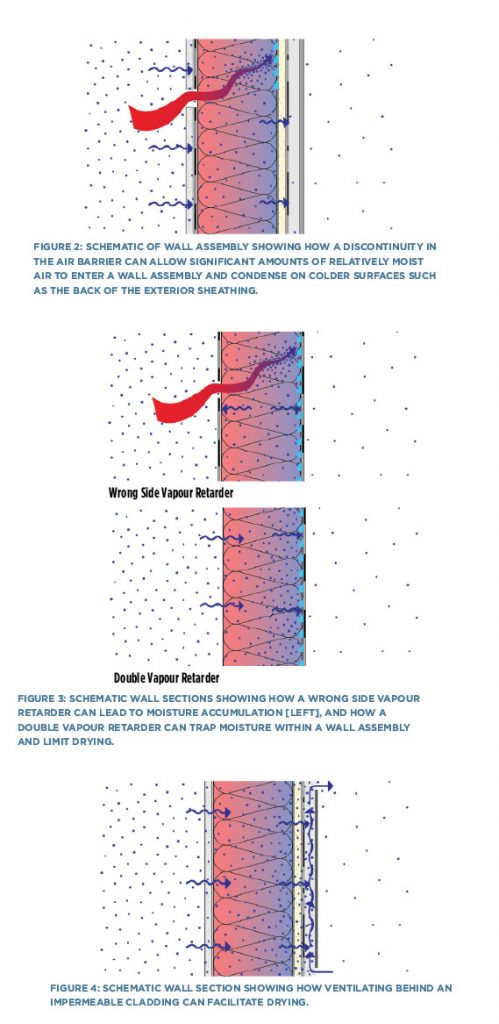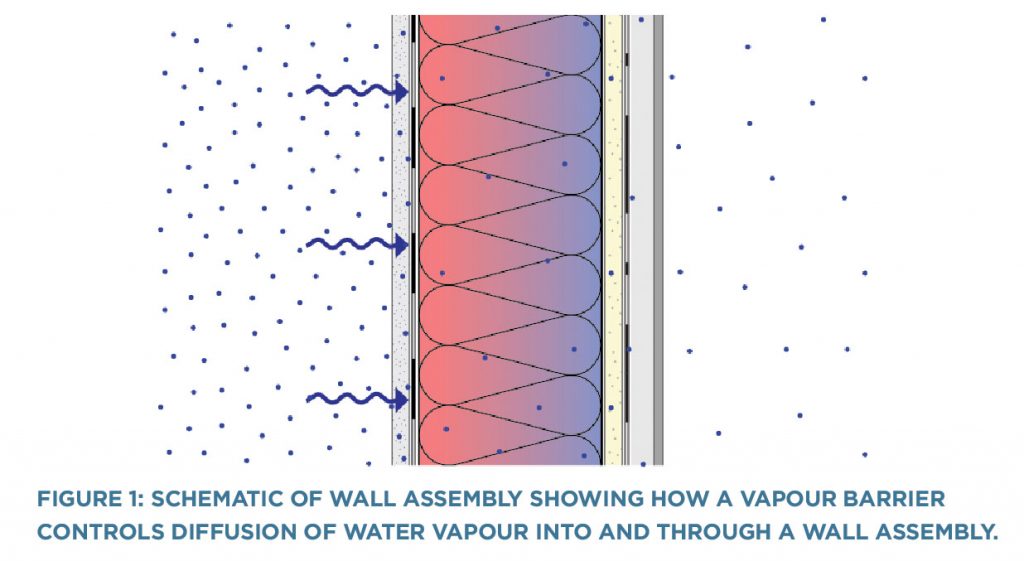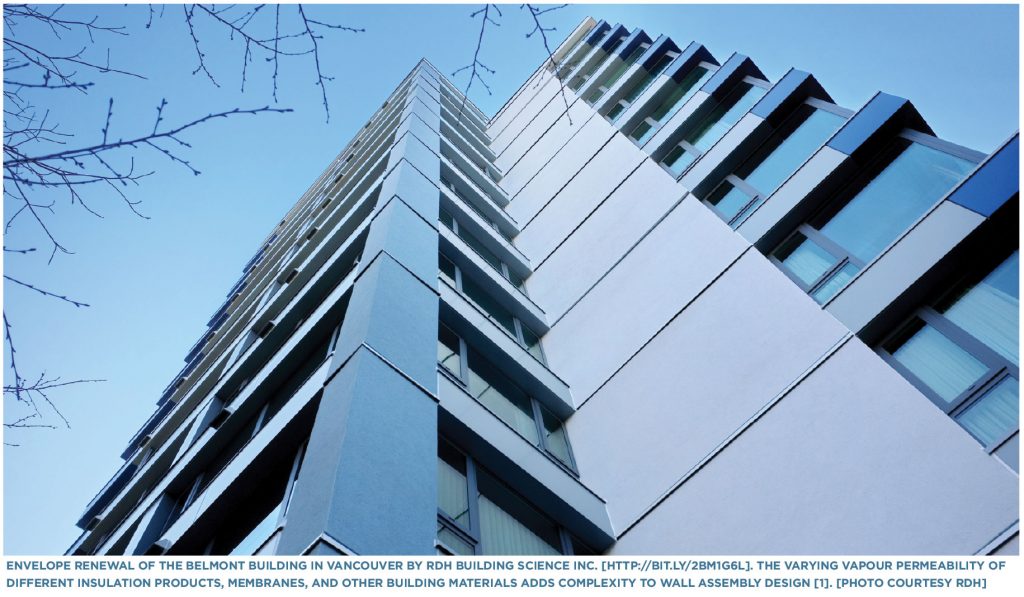VAPOUR DIFFUSION AND CONDENSATION CONTROL IN HIGH-PERFORMANCE BUILDINGS
Overview
More stringent energy codes demand higher levels of insulation for external walls, and in many cases this means using exterior insulation, either as a substitute for traditional cavity insulation, or to supplement it. Additional insulation thickness and changes to the insulation location require additional consideration with regards to vapour diffusion and condensation control.
The varying vapour permeability of different insulation products, membranes, and other building materials adds complexity to wall assembly design.
Some insulation materials, like mineral wool and fibreglass are vapour permeable, while others, like XPS, polyisocyanurate, and closed-cell spray foam are relatively impermeable.
Energy codes are silent on this issue and building codes can be confusing in regard to the selection of exterior insulation and vapour diffusion control for walls. This article clarifies and provides guidance on vapour diffusion and condensation control in these new wall assemblies.
Building Enclosure Basics
An exterior wall physically separates the outdoor and indoor environments. The differences in temperature, moisture, and air pressure between the outdoors and indoors result in loads that the wall must control or accommodate. Insulation is used to control heat flow, an air barrier is installed to control air flow, and claddings, flashings and membranes are used to control water penetration. The selection of a particular arrangement of material layers, and the vapour permeance of those layers will control vapour diffusion.
Principles of Vapour Diffusion
Vapour diffusion is the passage of vapour molecules through materials [e.g. wood, insulation, drywall, etc.] as a result of vapour pressure differences.
Vapour diffusion flow always occurs through an assembly from the high to low vapour pressure side, which most often is from the warm side to the cold side because warm air can hold more water than can cold air. In cold climates, this means that vapour diffuses primarily from the heated interior to the colder outdoors.
Overall, the direction of the vapour drive has important ramifications with respect to the placement of materials within a wall assembly. Improper use of vapour impermeable materials within a wall can lead to condensation on colder surfaces and lead to damaged materials and fungal growth.
To control vapour diffusion within wall assemblies, vapour retarding materials are used. All building materials provide some resistance to vapour diffusion that varies depending on the properties of the material. These properties can change with the relative humidity and moisture content, age, temperature, and other factors. Vapour resistance is commonly expressed using the inverse term “vapour permeance” which is the relative ease of vapour diffusion through a material. Building codes group materials into classes [Classes I, II, III] depending on their vapour permeance values. Class I [<0.1 US perm], and Class II [0.1 to 1.0 US perm] materials are considered impermeable to near impermeable respectively and are known as “vapour barriers”. Some materials that fall into this category include polyethylene sheet, sheet metal, aluminum foil, some foam plastic insulations [depending on thickness], self-adhered [peel-and-stick] bituminous membranes, and many other construction materials.
Class III [1.0 to 10 US perm] materials are considered semi-permeable and typical materials that fall into this category include latex paints, plywood and OSB [depending on the relative humidity], and some foam plastic insulations [depending on thickness].
The Class of vapour retarder [I, II, or III] is used within many building codes and building enclosure design publications to provide guidance for the selection of appropriate vapour control layers within wall assemblies in North American climate zones. This guidance is also based on the expected indoor conditions for certain building types which is related to exterior climate, indoor moisture generation rates combined with ventilation rates.
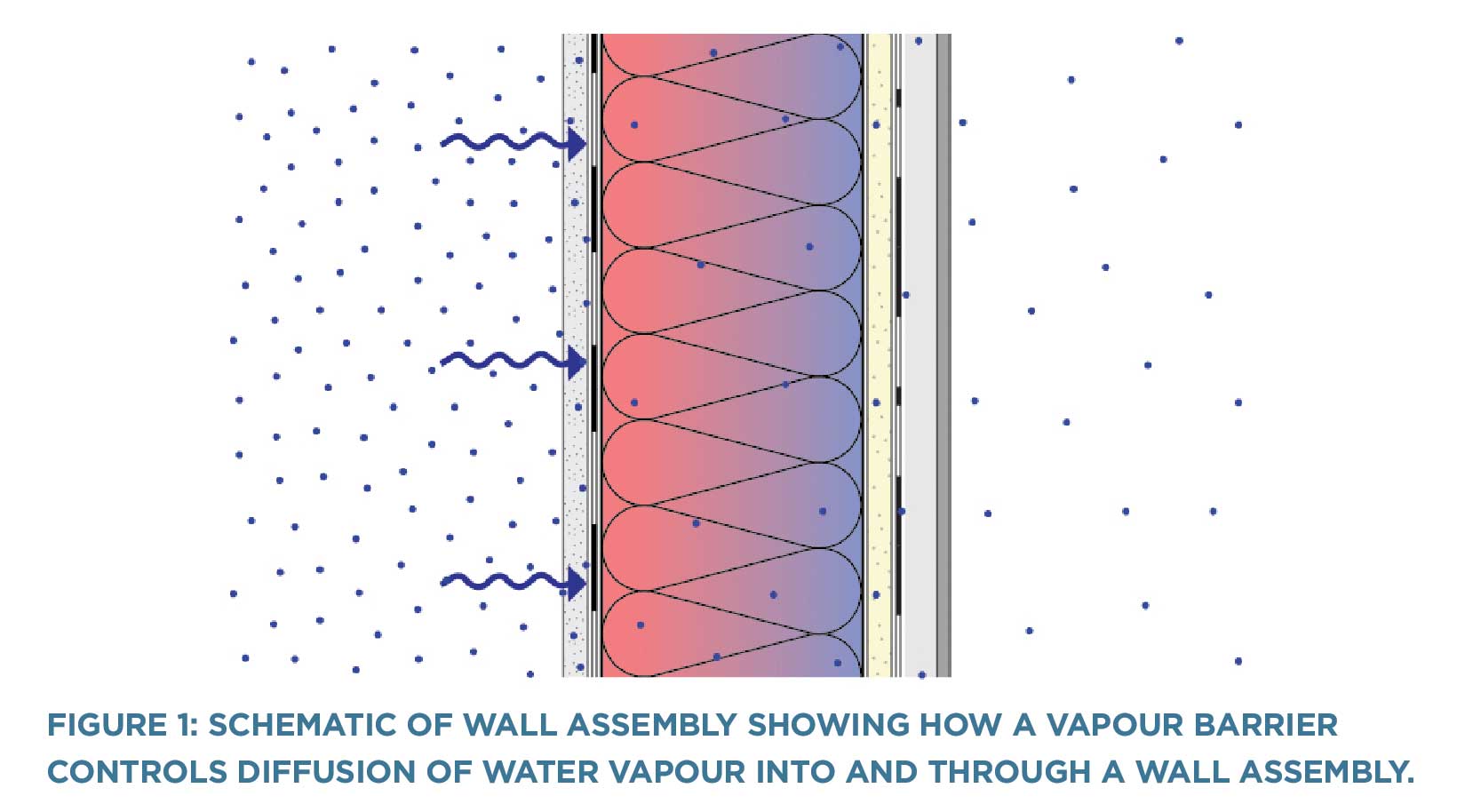 Figure 1 illustrates how a vapour retarder can be used in a cold climate to control the diffusion of vapour through a wall assembly.
Figure 1 illustrates how a vapour retarder can be used in a cold climate to control the diffusion of vapour through a wall assembly.
Vapour diffusion is typically thought of as a negative phenomenon, one that needs to be completely stopped. In reality, vapour diffusion is also a positive mechanism that can be used to the designer’s benefit, and is a very important drying mechanism for a wall assembly. In fact, vapour diffusion is the only process through which the concealed spaces of most wall assemblies are able to dry in service.
The control of vapour diffusion within a wall assembly is a balance of minimizing or managing wetting sources and maximizing drying potential should the wall be constructed wet, or somehow be wetted in-service. This is particularly important with highly insulated wall assemblies as more insulation means less heat energy is available to dry moisture from within assemblies.
Air Leakage
While vapour diffusion is a relatively slow process which can take extended periods to accumulate enough water to be of concern, air leakage in wall assemblies can act much more quickly and deposit large amounts of water in a short period of time. Air leakage is driven by air pressure differences between the interior and exterior of a building which can be created by a number of different factors including ventilation systems, wind, and stack effect [created by indoor to outdoor temperature differences]. These pressures drive air through wall assemblies from the high pressure side to the low pressure side. Importantly, air pressure differences are not the same as the vapour pressure differences which drive vapour diffusion.
To control air leakage in building enclosure assemblies like walls, an air barrier is installed. Unlike diffusion, air leakage is not typically governed by material properties of this air barrier. Instead, air leakage most often occurs at discontinuities and interfaces [i.e. holes] in the air barrier. Consequently, prevention of air leakage depends primarily on detailing, material compatibilities, and quality control during both the design and construction process. Notably, air leakage can bypass the vapour barrier and consequently is an independent phenomenon from vapour diffusion.
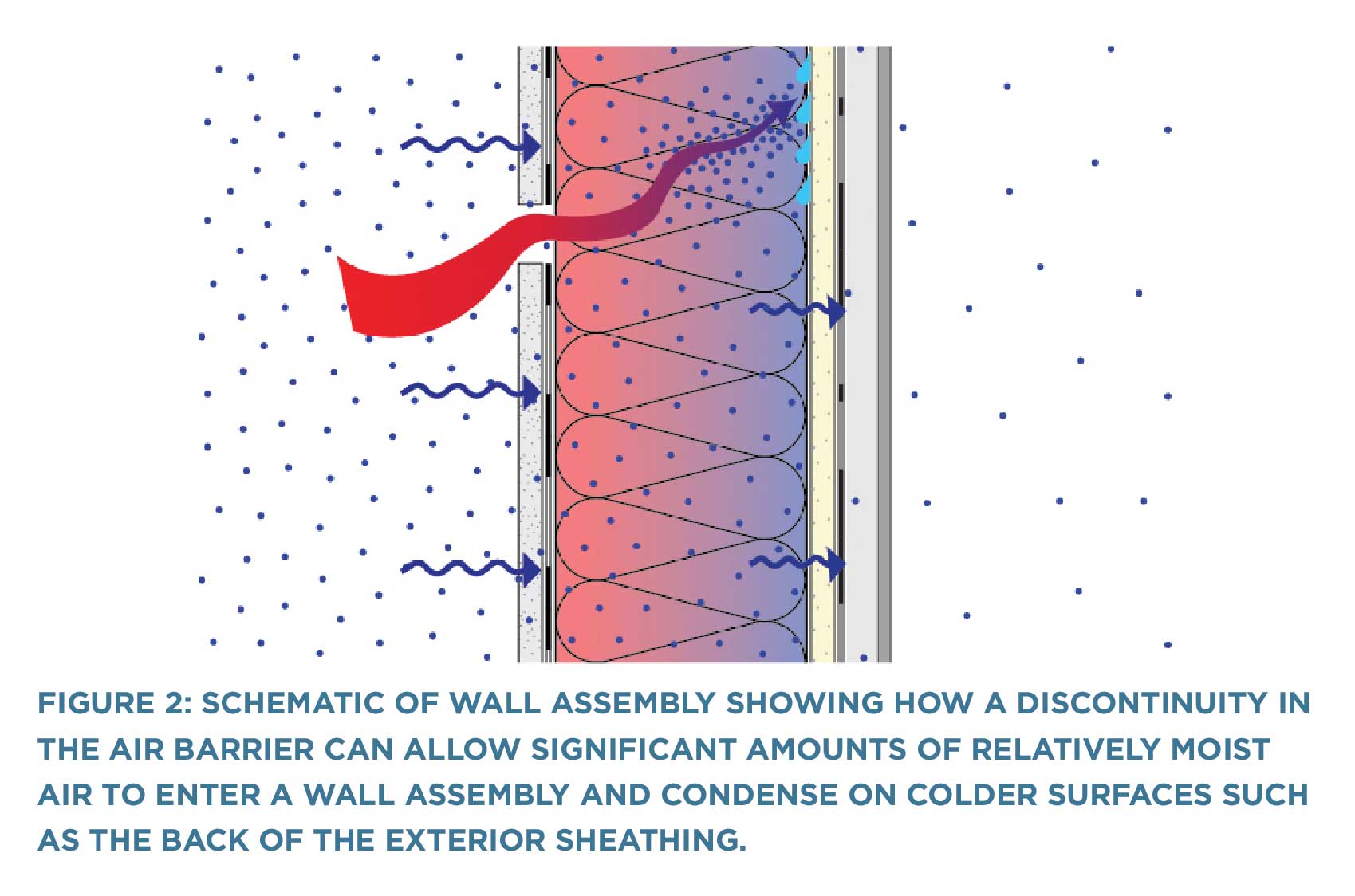 When air leakage does occur, it can carry moisture with it, and if this air then comes in contact with a surface that is below the dew point temperature of the air, condensation can occur. The dew point temperature is the temperature at which the air is 100% saturated with moisture, and consequently if the air is cooled below this temperature, it can no longer hold all of the moisture it contains and it will deposit the moisture on these colder surfaces. Condensation from air leakage can deposit significant amounts of moisture within a wall and potentially lead to fungal growth and/or degradation.
When air leakage does occur, it can carry moisture with it, and if this air then comes in contact with a surface that is below the dew point temperature of the air, condensation can occur. The dew point temperature is the temperature at which the air is 100% saturated with moisture, and consequently if the air is cooled below this temperature, it can no longer hold all of the moisture it contains and it will deposit the moisture on these colder surfaces. Condensation from air leakage can deposit significant amounts of moisture within a wall and potentially lead to fungal growth and/or degradation.
Location of Vapour Retarders
While vapour retarders can be used to control vapour diffusion and consequently prevent condensation, installation of these types of materials at the wrong location within an assembly can also cause significant moisture problems. Typically, there are two conditions that can be created which are detrimental: wrong side vapour retarders, and double vapour retarders.
Wrong side vapour retarders refers to when a vapour retarder is placed on the low vapour pressure side [typically the cold side] of a wall assembly. Locating a vapour retarder in this way restricts vapour diffusion through the wall and creates a potential condensing plane within the wall assembly.
 Double vapour retarders refers to when a vapour retarder is installed at two different locations in an assembly such that any moisture which manages to get between them is unable to dry effectively. When the materials between the vapour retarders are moisture sensitive, this trapped moisture can potentially lead to damage. Moisture between the vapour retarders may be the result of air leakage, rainwater ingress, or built-in construction moisture. Figure 3 illustrates schematic wrong side and double vapour retarder situations.
Double vapour retarders refers to when a vapour retarder is installed at two different locations in an assembly such that any moisture which manages to get between them is unable to dry effectively. When the materials between the vapour retarders are moisture sensitive, this trapped moisture can potentially lead to damage. Moisture between the vapour retarders may be the result of air leakage, rainwater ingress, or built-in construction moisture. Figure 3 illustrates schematic wrong side and double vapour retarder situations.
Stud Cavity Insulated walls
In cold climates, walls which are insulated only within the stud cavity provide vapour control with a vapour retarder on the interior side of the assembly. This is often provided using a polyethylene sheet vapour barrier, though other options such as vapour barrier paint, kraft paper, and smart vapour retarder products are also used. This interior vapour retarder limits the diffusion of moisture through the wall assembly towards the exterior.
Outward vapour diffusion drying can still occur from within the wall cavity to the exterior through the vapour permeable sheathing, membrane, and cladding. If this vapour retarder is not provided, vapour could diffuse from the interior towards the exterior. As the temperature drops across the insulation, for the same absolute humidity level [moisture] within the air, the relative humidity [RH] will increase, and when it comes in contact with a cold surface [below the dew point temperature], water can condense within the assembly. Most commonly this occurs on the interior face of the exterior wall sheathing. Even where condensation does not form, high RH levels are conducive to fungal growth on building materials, so it is ideal to keep the RH below 80% the vast majority of the time.
For comparison with the previous scenario, consider a stud insulated wall assembly in a cold climate with a vapour retarder material installed on the exterior side of the insulation under wintertime conditions. Vapour diffusion in this scenario occurs from the interior to the exteri-or; however, moisture is prevented from diffusing outwards and will accumulate in the form of condensation, leading to damage. This is an example of what can happen when a vapour barrier is installed on the wrong side of an assembly. The vapour barrier in this scenario could be created by the wrong type of sheathing membrane, the use of excessive self-adhered bituminous membrane application at penetrations and details, or the installation of a vapour impermeable cladding such as fibre cement panel, glass cladding, or metal siding.
A straightforward way to address vapour impermeable claddings is to provide an airspace and ventilation behind the cladding so that airflow from the outdoors will remove moisture deposited on the cladding by outward vapour diffusion. As many commercial claddings are impermeable [i.e. metal, concrete veneer, etc], this is commonly achieved by the construction of a drained and ventilated rainscreen cavity. Venting of an impermeable cladding is illustrated in Figure 4.

Exterior Insulated Wall Assemblies
Exterior insulation is often considered an effective way of achieving highly insulated wall assemblies, and can substantially reduce thermal bridging. In addition to these thermal benefits, exterior insulation can also provide a robust assembly with respect to vapour diffusion and condensation.
The use of exterior insulation changes the temperature profile through the wall assembly and consequently the back-up wall, be it sheathed steel stud, concrete, or CMU, is maintained relatively close to interior conditions. Additionally, since typically a sheathing membrane is applied to the back-up wall behind the insulation in these assemblies, moisture sensitive materials are generally all located on the interior side of the insulation and sheathing membrane where they remain both warm and dry, resulting in a very durable wall assembly.
 Figure 5 shows how in cold climates, a vapour impermeable sheathing membrane can be used to control vapour diffusion through these wall assemblies.
Figure 5 shows how in cold climates, a vapour impermeable sheathing membrane can be used to control vapour diffusion through these wall assemblies.
An important aspect of exterior insulated walls, is that their design makes them highly durable with respect to condensation due to air leakage. While air leakage in a stud cavity insulated wall can often lead to damage, this risk is substantially reduced in an exterior insulated assembly. Figure 6 illustrates an exterior insulated wall where air leakage occurs.
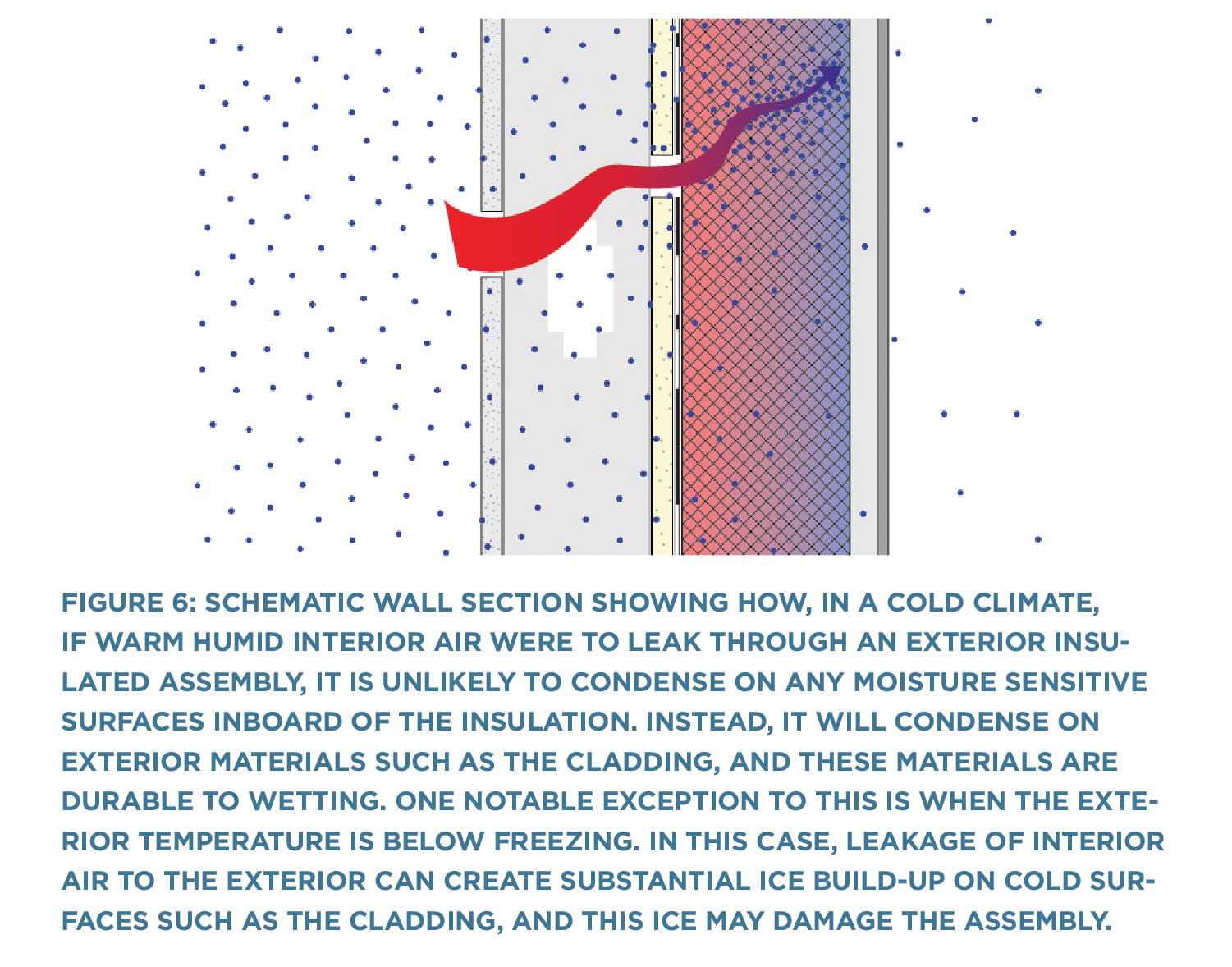
Split Insulated Wall Assemblies
In some cases it can be advantageous to use split insulated wall assemblies; that is, assemblies where insulation is provided both in the stud cavity and on the exterior of the sheathing [or less commonly as the sheathing itself in commercial buildings]. Usually these are used as they can provide the necessary R-value in a relatively compact [i.e. thinner] assembly. As one might guess, these walls essentially provide a mixture of the performance of stud cavity insulated and exterior insulated wall assembly, but there are a number of important considerations.
In a split-insulated assembly, the more insulation placed outboard of the sheathing compared to the insulation within the stud cavity, the closer to interior conditions the sheathing will be, and consequently the closer these walls will be to exterior insulated walls.
This concept is often expressed in terms of a nominal outboard to total insulation ratio. For example if R-6 of rigid insulation is placed outboard of R-14 batt insulation within the stud space for a total insulation amount of R-20 nominal, the approximate ratio is 30% [or 3:10] of outboard insulation excluding other materials. Overall, the lower this ratio, the closer the performance will be to an insulated stud wall, and the higher the ratio, the closer the performance will be to an ex-terior insulated wall.
Given that split-insulated walls fall somewhere between insulated stud wall and exterior insulated walls with respect to performance, there are important considerations with respect to vapour diffusion. Generally, the exterior insulation will keep the sheathing closer to interior conditions, but if it is a relatively small fraction of the overall insulation in the wall, the sheathing will still operate at conditions similar to the exterior. In this situation, the vapour permeability of the insulation should be considered.
Vapour Permeable Insulation
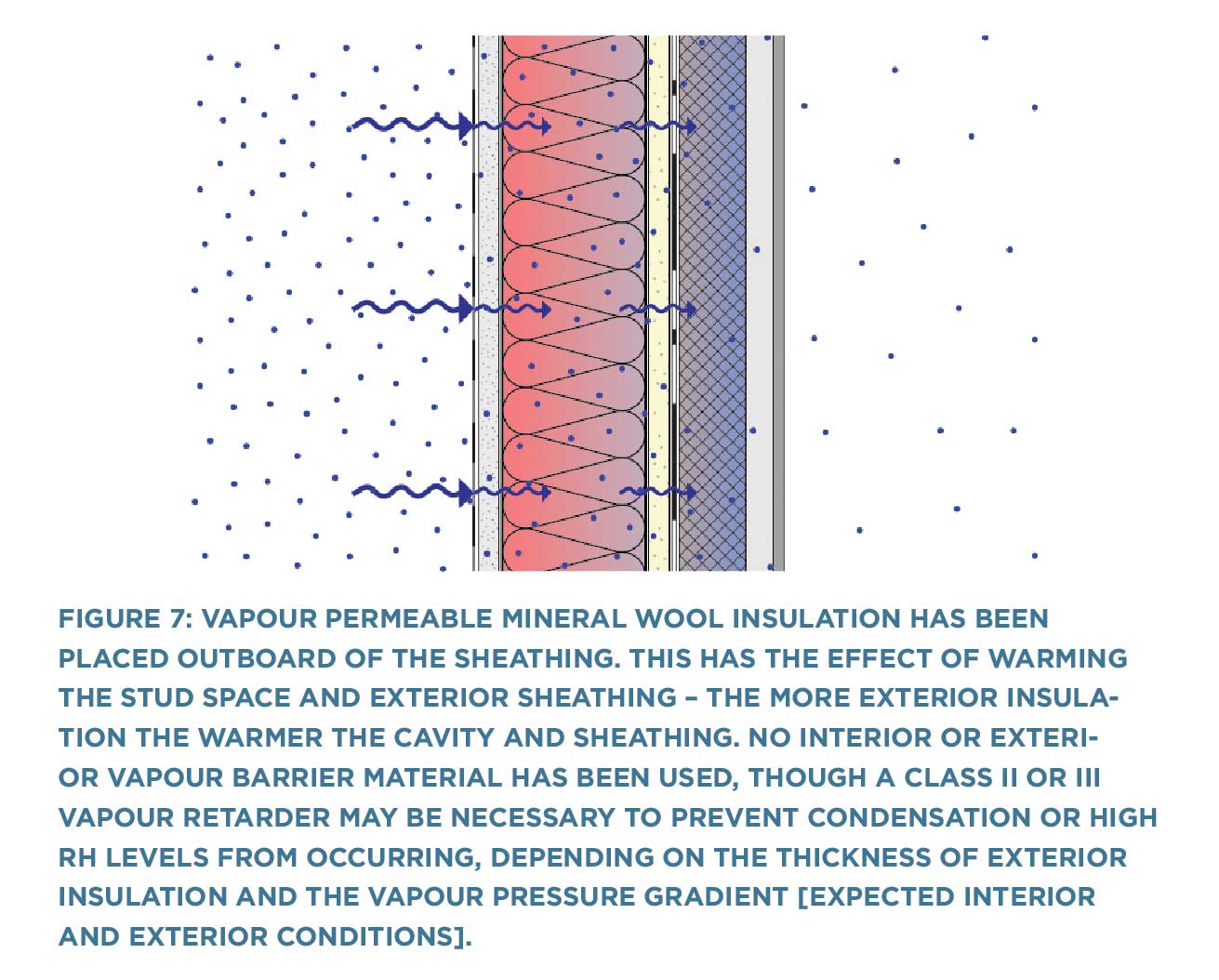 Figure 7 illustrates the split insulated wall scenario under wintertime conditions in a cold climate when using a vapour permeable exterior insulation
Figure 7 illustrates the split insulated wall scenario under wintertime conditions in a cold climate when using a vapour permeable exterior insulation
For moderately cold climates and most indoor conditions within commercial buildings, the installation of a few inches of mineral wool outboard of an insulated 6” stud wall is sufficient to ensure good performance when a Class III vapour retarder [latex paint] is used on the interior of the drywall. Good performance can generally be taken to mean maintaining the RH at the sheathing below 80%. For buildings with high interior humidity levels such as pools or museums, a Class I or II vapour barrier would likely still be required.
The vapour pressure difference from interior to exterior within this scenario is the same as the previous cases, and is not affected by the exterior insulation; however, the temperature within the stud cavity is warmer, and consequently the RH at the sheathing does not increase as much. As a result, condensation does not form within the cavity and the vapour passes through the sheathing and vapour permeable insulation without harm. The RH within the cavity behind the sheathing will depend on the insulation ratio and on the rate at which drying occurs through the sheathing, therefore the more vapour permeable the sheathing and insulation, the lower the RH within the cavity.
Because the sheathing temperature is increased, the risk of air leakage condensation is reduced which further improves the durability of this wall. With vapour diffusion and air leakage wetting addressed, the primary risk of moisture damage is from an external leak. However, because the sheathing is kept warmer by the insulation, it is able to dry out faster, and in this wall assembly moisture will dry both inwards and outwards by vapour diffusion through the relatively vapour permeable materials.
Vapour Impermeable Insulation
Consider the same wall assembly as in the previous scenario but with vapour impermeable foam insulation [i.e. XPS, polyiso, medium density spray polyurethane foam, etc.] used to the exterior of the sheathing. These insulation materials can be Class I or II vapour retarders depending on type, density, thickness, and facings.
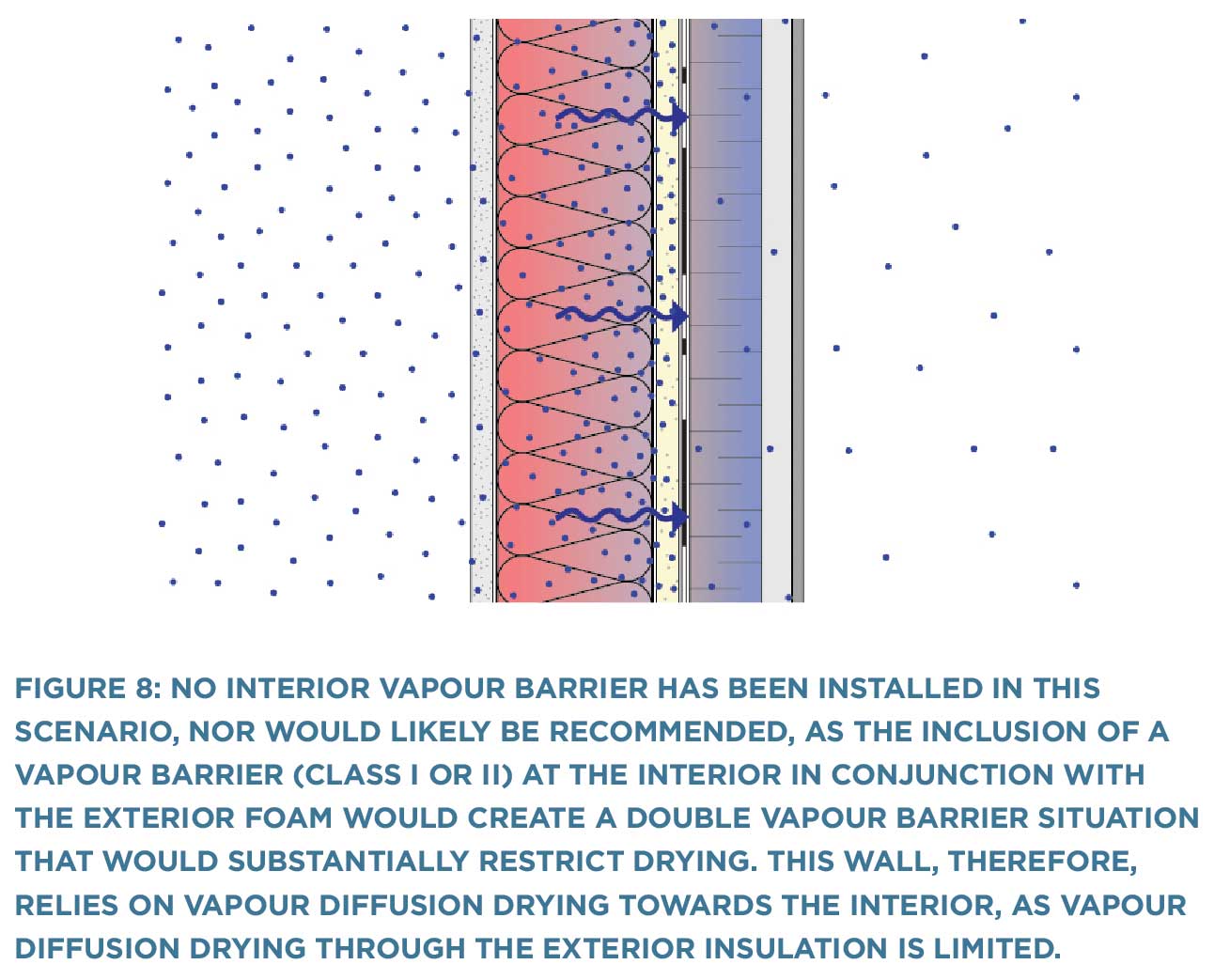 Figure 8 illustrates the use of vapour impermeable foam insulation with the same R-value as in the previous scenario placed outboard of the sheathing has the effect of warming up the rest of cavity – the more exterior insulation the warmer the cavity and sheathing.
Figure 8 illustrates the use of vapour impermeable foam insulation with the same R-value as in the previous scenario placed outboard of the sheathing has the effect of warming up the rest of cavity – the more exterior insulation the warmer the cavity and sheathing.
The vapour pressure difference from interior to exterior within this scenario is the same as in the previous scenarios; it hasn’t been affected by the presence of the exterior insulation. While vapour diffusion outwards is significantly slowed, or stopped, condensation does not occur within the wall cavity because the temperature is warm enough to keep the RH below 100%. While condensation does not likely form within the cavity of this assembly, moisture is prevented from travelling through the exterior insulation, which can be an issue in the event of a leak or if there is not enough insulation outboard to prevent air leakage condensation. The RH within the cavity behind the sheathing will depend on the insulation ratio and the effective vapour permeance of the foam insulation. With this assembly, it is generally safer to have more exterior insulation [or a higher insulation ratio] than with vapour permeable insulation so that the RH is kept below 80% to reduce the risk of fungal growth.
In terms of balancing wetting sources and drying ability, this is a more sensitive wall than the previous scenario as a result of using impermeable exterior insulation.
Similarly to the exterior insulated wall with vapour permeable insulation, the risk of air leakage condensation is reduced for this wall due to the increased sheathing temperature. If vapour diffusion and air leakage wetting are addressed by placement of sufficient exterior insulation, the primary risk of moisture damage is from an external leak. In the event of a leak, drying outwards by vapour diffusion is restricted by the foam, and drying can only occur in the inward direction. Solutions to improve outward drying include providing a small drainage layer behind the foam or to use more vapour permeable insulation. The relative tightness in which the rigid foam board insulation is installed and how the joints are sealed will also affect the outward drying ability.
Summary
The control of vapour diffusion within walls is a balance between minimizing wetting and maximizing drying ability. Correctly placed vapour control layers prevent excessive moisture from diffusing into wall assemblies and potentially condensing, while vapour permeable materials allow moisture to diffuse out and are beneficial to drying performance. In the design and construction of commercial walls in cold climates, it has been common practice to install a polyethylene sheet vapour barrier at the interior of the insulation to control vapour flow [and often air flow] and therefore limit vapour diffusion wetting while using vapour permeable materials to the exterior to encourage drying.
When insulation is added to the exterior of the walls, as in the case of a split-insulated or exterior insulated walls, this insulation maintains the temperature of the stud cavity and exterior sheathing closer to interior conditions, reducing the potential for vapour diffusion and air leakage condensation to occur within the cavity. The more insulation that is installed outboard of the sheathing, the closer to interior conditions the stud cavity will be, and the lower the risk. Wherever possible, the exterior insulation ratio should be maximized, and fully exterior insulated walls work well in cold climates.
In cold climates, the type of insulation installed outboard of the sheathing [or as the sheathing] has an important impact on the vapour diffusion drying capability of the wall. Vapour permeable insulation such as mineral wool or fibreglass will allow for greater outward drying than can be achieved with vapour impermeable insulation such as foam plastics; XPS, polyiso, spray polyurethane foam insulation. This greater drying ability generally results in improved durability of the wall assembly.
In some cases, the change in temperature profile due to the addition of exterior insulation means that a vapour barrier may no longer be needed at the interior in cold climates, and alternate strategies such as a latex paint may be used instead of polyethylene. When a vapour impermeable exterior insulation is used in cold climates, an interior vapour retarder should be avoided to prevent trapping moisture within the wall assembly, or potentially an adaptive permeance smart vapour retarder material could be used.
Overall, the correct selection and placement of vapour impermeable materials within wall assemblies is fundamental to their durability, and is increasingly important as we design more highly insulated walls to meet ever more stringent energy performance expectations. In the worst case scenario, failure to correctly account for the impacts of vapour diffusion in these high-performance assemblies can lead to damage and premature failure of wall assemblies.
Lorne Ricketts, MASc, P.Eng. Is a building science engineer at RDH Building Science Inc. in Vancouver.
The quiz is available at: http://sabmagazine-education.com/




